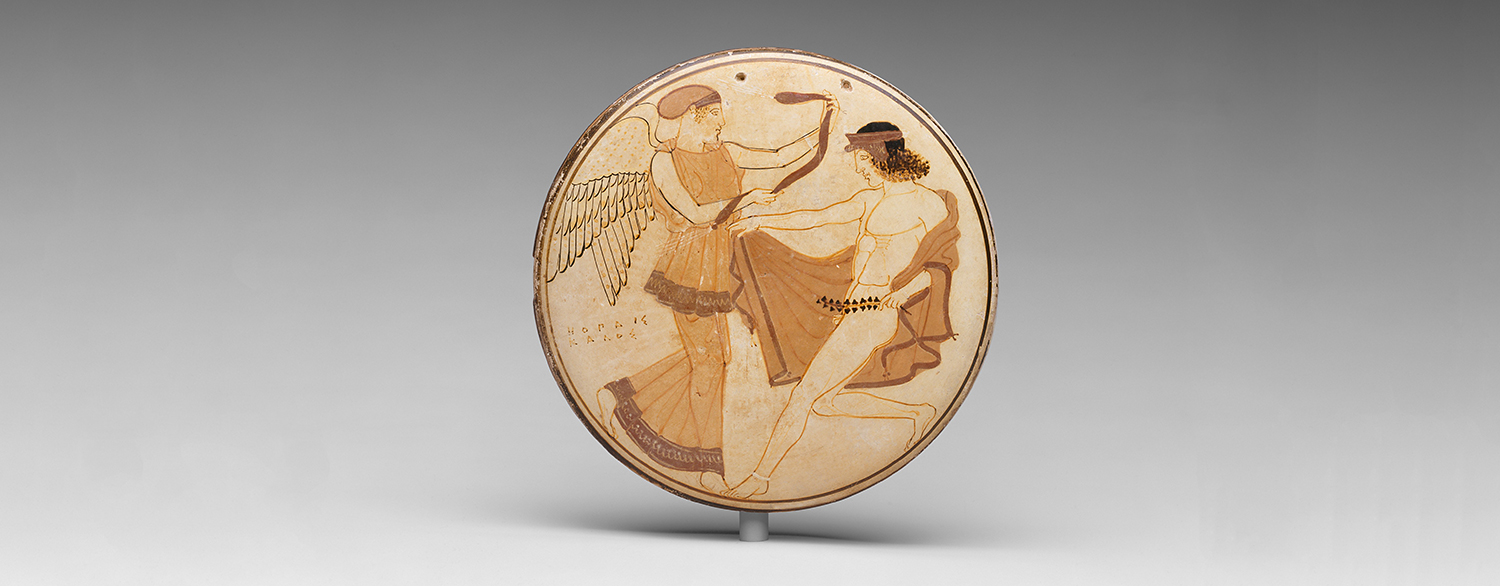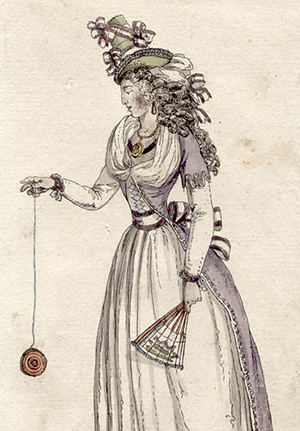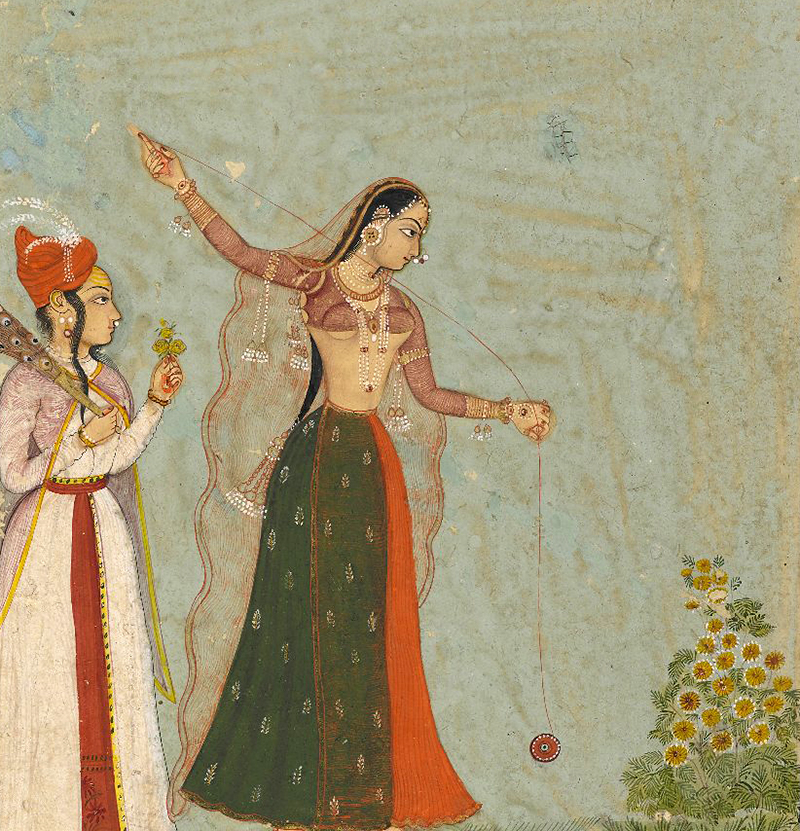December 2020
diabolo, l’emigrette & la dame de pique
1 December 2020, around 6.14.

Victory offering a fillet to a pretty boy on a terracotta bobbin,1 circa 460–450 BCE, from the Metropolitan Museum of Art
A lady’s pique suggests spitefulness arcane, inscrutable.
It’s always the way of things, you are merrily reading a newly acquired translation of Pushkin’s ‘Queen of Spades’ instead of starting your workday, and as you are waiting for the Countess to return from the ball in section three and encounter the not particularly pleasant Hermann (not quite Germain), you observe, with Pushkin, with Hermann, the decorations in the Countess’s room – the porcelain shepherdesses, the trinket boxes, the fans, the bandalores.2 The bandalores? The bandalores – ah, yes, the yo-yos.3 This seems like an odd addition to a lady’s tchotchkes, so you consult a second translation (because of course you have more than one to hand), which translates the word in question as ‘tops’.4 This seems less objectionable as bric-à-brac, but now that you’re looking into the matter you simply must know: what on earth was Pushkin talking about? In consulting with a learned colleague, you learn that Pushkin used the word рулетки (note the plural), which despite its similarity to roulette (which would keep up the gambling theme) the ever (over) helpful lexicographer Dahl defines as a ‘French toy’ on a cord that sounds very much like a yo-yo.5

ROSETTA. They are pretty, but there is no great ingenuity in playing with them, I think.
MATILDA. Oh no, it is all a knack.
ROSETTA. I like better a plaything which requires more ſkill, or elſe is an exerciſe.
The matter could end there – you know what Pushkin meant, after all – but you feel that you should add that the OED is not particularly helpful on the bandalore, hazarding no speculation on its origins and taking a limited view of its history. The entry does include a reference to an 1864 issue of The Athenæum which mentions Thomas Moore’s gossip about the Duke of Wellington toying with a bandalore (originally published in Blackwood’s), as well as another quotation indicating that even in 1824 a bandalore was a sadly ‘gone-by’ toy, such as an old bachelor’s servant might use to divert an irruption of children. This incidentally makes it plausible for a countess to have a few lying around circa 1833/4 – which would be of a piece with the rest of her out-of-date style.
This does not, however, give you much of a sense of when or or where or why the bandalore was a fashion, and the word keeps running through your head, spinning away only to whirl back again, so you delay the beginning of your work still further to find some seven or more references, including a letter from Horace Walpole to Miss Mary Berry dated 12 October 1790, in which the toy/game is mentioned: ‘I have dined to-day at Bushy with the Guilfords, where were only the two daughters, Mr. Storer, and Sir Harry Englefield, who performed en professeur at the game I thought Turkish, but which sounds Moorish; he calls it Bandalore.’ There is also the deeply dull Dramatic dialogues for the use of young persons (1792) by Elizabeth Sibthorpe Pinchard, in which bandalores are called ‘Prince of Wales’s toys’ because ‘They are all the faſhion. The Prince of Wales brought them in’ (pp. 10–11).6 Sixteen-year-old Mary Spilsbury exhibited a painting of ‘The bandalore, or fashionable toy’ at the Royal Academy, also in 1792.7

Mughal-style watercolor of a woman, ca. 1770, from the Brooklyn Museum
The toy appears in a plate – featuring the latest fashions from France – in the October 1791 issue of Journal des Luxus und der Moden, which identifies it as a Joujou de Normandie (581).8 The French connection is stressed in Notes & Queries, where the redoubtable Skeat – annoyed by the unhelpfulness of the OED – provides a potential origin in ‘bande de l’aure, string of breeze, or whizz’. A a disgruntled correspondent (why two zeds in whizz?!) to the periodical thought this preposterous: the word is clearly East Indian, not least because the French call the toy l’emigrette.9 There is a 1792 engraving in the BnF of ‘La belle Adeline faisant aller son Emigran’ – the emigran in question being, of course, a yo-yo. Its keyword (which leads to four other engravings, including one from 1791 of the young dauphin yo-yo-ing his way towards Coblentz) is l’emigrette.10 It is tempting to read the popularity of yo-yos as an example of aristocratic frivolity, as though they were in some way equivalent to Nero’s fiddling, more concerned with toys than politics.
If you happen to search for historical images of the yo-yo, a 1770 Mughal-style opaque watercolor is one of the first images you will find that provides any sort of provenance or even the inkling of a context. It shows a young woman standing on a pedestal playing with a toy that looks very much like a yo-yo, although her raised right hand contains some sort of distaff or handle at the end of the string attached to the more usual yo-yo wheel or bobbin. The notes to the image suggest that she is occupying the leisure enforced by the absence of her lover. The yo-yo is an apt image for such separation: the bobbin spins away, but in skillful hands is drawn back along the string of attraction to its starting point.11 A similar sort of metaphorical reading can be applied to the images of the French émigrés with their emigrettes. They are driven away by force, by fear, by threats, but with skill, with luck, with the right knack, could hope to return along the path linking them to their starting place.12
In considering the bandalore and ‘The Queen of Spades’, the ace up my sleeve (as it were) was supposed to be the diabolo, another string-and-bobbin based toy which, according to the 1911 Britannica, originated in China and was popular in France around 1812 as le diable. I was quite certain, as I led you merrily along the history of the bandalore, that it would turn out to be a mistranslation – that the diabolo, which I knew to have been popular in France not precisely when Pushkin was writing but somewhat before, would be a better choice. It would capture the infernal, the uncanny sense of the story: it would be right, it would be what the sense demanded. But the more I looked at what I found, the more it seemed to me – unnatural, unexpected as it was – that bandalore was indeed more appropriate, drawing the melancholy thread of the Countess’s connection to her émigré friends long after her Paris heyday as the ‘Muscovy Venus’ had passed.13 It was something of a shock, as though I had backed the wrong horse or picked the wrong card in a game of chance, and I was bit stunned, as though the author – cheeky devil – had outfoxed me from beyond the grave and offered a knowing wink through the translator’s sleight of hand. I went about my daily work in a sort of daze for longer than I care to think about before I could shake off my chagrin at this unforeseen reversal. Only then did I recall that I had not yet finished reading any of the translations of ‘The Queen of Spades’.
- This image may depict an ancient Greek yo-yo, but it could just be some sort of bobbin. Stephen Miller, in Ancient Greek Athletics (Yale UP, 2004, p. 169f.), briefly considers the yo-yo, which appears on vases from the fourth century; an article in the 1923 Journal of Hellenic Studies also posits that a yo-yo appeared in the upraised hand of a Hellenistic bronze statue of an ephebe. The Greek word for the yo-yo is uncertain, but the top, a related spinning toy also activated with string, is a βέμβιξ. It seems plausible to me that this may also mean yo-yo, but there is no concrete evidence for this assertion. [↩]
- Translation by Anthony Briggs, from Pushkin Press, 2012. [↩]
- The history of the word yo-yo is adequately treated in the OED, coming from one of the languages of the Philippines. It is currently a proprietary name (popularized by the Louis Marx company in the 1920s), but appears to have more or less lost its battle to be respected as such. [↩]
- Translation by Ivy and Tatiana Litvinov, published by Signet, 1961. [↩]
- Further research reveals that Margaret Sutherland Edwards (1892) went with ‘all the little playthings’, Thomas Keane (1894) went with ‘roulette’, and Pevear and Volokhovsky (2016) followed Briggs with ‘bandalores’; other translators eschewed the vocabulary quiz entirely by abridging the text as they went. [↩]
- They also make an appearance with battledores and shuttlecocks in the even more dully didactic The Grandfather; or, The Christmas Holidays (1816) by Elizabeth Sandham. [↩]
- An image of this does not appear to be conveniently available online, if indeed it survives. [↩]
- Perhaps this is why most references to the image online claim it first appeared in a French fashion journal of the same year – or perhaps the image in the German fashion journal was copied from an earlier French one that either has not survived or has not yielded to my searches online. [↩]
- Whether they still do is not relevant here, but it seems it is now called le yo-yo. [↩]
- Also available as part of an online exhibition of images of the French Revolution hosted by Stanford, if you would prefer English metadata. [↩]
- In unskillful hands, the results are what you would imagine: distance at best, a deplorable tangle at worst. [↩]
- This is an interpretation lightly mentioned in the limited preview available for Play in the Age of Goethe: Theories, Narratives, and Practices of Play Around 1800 (Bucknell UP, 2020), edited by Edgar Landgraf and Elliott Schreiber, which looks like it might be interesting. [↩]
- Trying to sort out the somewhat inexact chronology presented by the Countess’s grandson (who prefers anecdotes and namedropping to prosing through a strict sequential logical narrative: whatever his other faults, he does not seem to have been a bore), I managed to distract myself chasing down various ducs de Richelieu, including the dashing fifth duc, who one wishes were the Countess’s flirt (but it was probably his father, the fourth duc) and who, himself, ended up in Russia (including a tour as mayor of Odessa) after a stint in Vienna. His hunchback wife outlived him, but it is not at all clear where she spent her time. In looking up, or trying to look up, these details, one discovers that the timing of the story does not work out with perfect precision (a finicky fact-checker might be tempted to call Pushkin out): Princess Natalya Petrovna Golitsyna (aka Усатая принцесса), one of the models for the Countess, was recalled from Paris with her family in 1790, just a little before the first textual evidence (from Walpole – though one must allow that it would take time for a toy at the forefront of fashion to develop a paper trail) of the bandalore, but it is close enough for the toy to be an acutely observed detail, one that does not grandstand its cleverness, but impresses by its elegance, economy, and verisimilitude. [↩]
velleity
11 December 2020, around 5.41.
Nothing is quite what I’m expecting at the moment. If November was a month in which I could read fluently and easily and joyfully and curiously, December is, or currently seems to be, a month in which nothing makes sense, and every word on a page makes me peevish. I am tempted to retreat into my phone, into the blancmange mass of library ebooks, into reading alternate pages from twenty different books and following none of them – indeed, not even making it to the end of a clause, much less a sentence. I wish to read, but the habit of authors to jockey for position, to namedrop, to be precious and coy, to not really know what they are talking about though they have been given a contract to write something like a textbook, to – in short – be human with human foibles and not demigods of immaculate detail, this habit of mere humanity detracts the joy from even the limited, flawed execution of whatever project it is that they have undertaken and leaves me trapped, as though in a waiting room, apart from the pleasure of reading.
15.xii.2020
15 December 2020, around 17.56.
‘In the art of not living one is not ephemerally permanent but permanently ephemeral.’ —Laura (Riding) Jackson (Anarchism Is Not Enough)
16.xii.2020
16 December 2020, around 12.05.
‘The conversion of nothing into something is the task of criticism. Literature is the storehouse of these rescued somethings.’ —Laura (Riding) Jackson (Anarchism Is Not Enough)
flurried
17 December 2020, around 6.23.

A glimpse of the season’s first snowfall, through the window, at night.
The first snow of the season (or the first snow I was awake to see falling) reminded me of something that I’ve been meaning to do. I am trying to read more patiently – not necessarily more attentively or carefully, but more patiently, or perhaps I should say persistently. It has been hard to concentrate, and even when this has meant discovering the unexpected meanings of tiny details, it has also meant a detachment, a standing apart from my reading self in the attempt to keep that reading self on some sort ‘track’.
Involved in this monitoring and attempt at patience (or persistence) has also been an attempt to shift away from reading ebooks and back into the folds of paper books, turning to the comfort of the tangible from the comfort of the immediately available. This is partially from a desire to return to the visually half remembered (it was on the verso of a page about a third of the way through, about an eighth of the way down), rather than relying on the conveniently searchable (magnifying glass » ‘letch’ » search), but also because I wish to read things that are disconcerting or disorienting, rather than have the experience of reading be so – as it is on the phone, where the text is at the mercy of the immediately changeable context of the app, which jumps, stutters, expires, observes. I would like my reading to, after all, be my own.1
A snapshot of sorts. Like the image above, it captures some of the things I’ve been trying to persist in reading.
- Collections of essays, such as Moyra Davey’s Index Cards, which is perhaps too world weary for me, and Briallen Hopper’s Hard to Love, which is charming, but occasionally feels too digital, as though it would be more comfortable as a series of blog posts (e.g.);
- Shakespeare’s plays, which I’ve been reading in an idiosyncratic order – I got a bit bogged down in the histories, mostly because of Falstaff, who kept asking to be made a project of, a request which must be denied; and
- Ronald Hutton’s history of the figure of the witch – an astringent and wide-ranging book that neatly models many of the good features of academic writing in terms of orderly presentation of ideas, but is not, I would say, compulsively readable.
I’ve also been trying to read around the work of Laura (Riding) Jackson, but my attempts have been tentative, because following her thinking (or meaning) requires attention, which I do not always have and which I am not convinced will be worth it (after all) to use. With reading (of this and other things), I am coming to the conclusion that, even if the work itself is not worth the careful consideration, knowing for something like a certainty that this is the case (i.e., that it is or is not worth the effort of considering) would be.
- Edited to add: this thinking was in part (a small part, but still a part) shaped by Andrew Piper’s Book Was There: Reading in Electronic Times (Chicago: Univ. of Chicago Press, 2012), which I remembered at lunchtime, when I picked up my phone to read the ebook, which in turn was part of my effort to clear out my digital library to concentrate on paper books. [↩]
19.xii.2020
19 December 2020, around 14.24.
‘I read all the time: newspapers, magazines, fiction, nonfiction, but it’s important for me to feel interpolated; to feel like the thing I am reading will lead to another and another…’ —Moyra Davey (‘Opposite of Low Hanging Fruit’, in Index Cards)
21 December 2020 – Portland
21 December 2020, around 10.41.
Tumbled out of the apartment building, only to find myself in the neighborhood where I have lived, on and off, for perhaps ten years.1 The neighbors pass, masked, some with their dogs and others circumspect, head bowed against the mizzle. It is the solstice, and there’s little I’d like more than to hibernate a while, but today’s the day for heading to the post office through the rain and editing papers from foreign places and all of life’s other stores and stories. Thus much and watching the score of years – sufficient in itself.
- Perhaps more, perhaps less: it depends on how you want to count – I am not particular. [↩]
playing favorites
29 December 2020, around 5.01.
The other evening I was annoying myself by trying to think up answers to the question ‘what is your favorite book?’ It’s a silly question, because books are good for so many different things – one (generally) wants different things from a cookbook and a poetry chapbook; and it’s a different question from ‘what do you like to read?’, which usually reduces one to puffing recent releases, listing obscure out-of-print titles, or making up genres with whimsical names (especially if the name raises more questions than it answers). In teasing myself with the question I considered names and titles, weighing them, and it was interesting to see which books withstood this rapid, unthoughtful measure:
- Herodotus, yes
- The Iliad, no
- Kenkō, yes
- The Odyssey, maybe?
- Tristram Shandy, yes
- Villette, no
- Proust, no
- Black Lamb and Grey Falcon, yes
As I didn’t bother applying the question to books I was not, in some measure, fond of, the answers that sprang to mind (with the oracularity of any omphalos, from the gut) at times surprised. My taste runs more to the picaresque than I would have thought, though I suppose the fondness for digression doesn’t surprise.
It is curious, of course, that just because one likes a book, it doesn’t mean it’s good – and, conversely, just because a book is good, one doesn’t necessarily have to like it. It is not a moral fault to dislike a book, not least because disliking a book does not necessitate failing to appreciate it. It is also not a moral fault to a like a book, though I suppose being ashamed of liking something is a different matter entirely and calls for more introspection.
A view (52)
30 December 2020, around 8.49.

